Android数据库SQLite的使用示例
发布于:2014-7-22 9:55 作者:admin 浏览:2703 分类:Android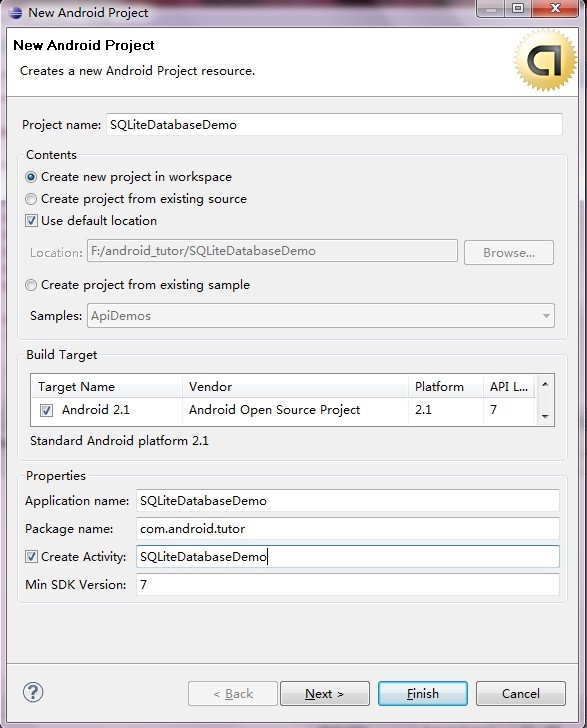
package com.android.tutor;
import android.content.ContentValues;
import android.content.Context;
import android.database.Cursor;
import android.database.sqlite.SQLiteDatabase;
import android.database.sqlite.SQLiteOpenHelper;
public class BooksDB extends SQLiteOpenHelper {
private final static String DATABASE_NAME = "BOOKS.db";
private final static int DATABASE_VERSION = 1;
private final static String TABLE_NAME = "books_table";
public final static String BOOK_ID = "book_id";
public final static String BOOK_NAME = "book_name";
public final static String BOOK_AUTHOR = "book_author";
public BooksDB(Context context) {
// TODO Auto-generated constructor stub
super(context, DATABASE_NAME, null, DATABASE_VERSION);
}
//创建table
@Override
public void onCreate(SQLiteDatabase db) {
String sql = "CREATE TABLE " + TABLE_NAME + " (" + BOOK_ID
+ " INTEGER primary key autoincrement, " + BOOK_NAME + " text, "+ BOOK_AUTHOR +" text);";
db.execSQL(sql);
}
@Override
public void onUpgrade(SQLiteDatabase db, int oldVersion, int newVersion) {
String sql = "DROP TABLE IF EXISTS " + TABLE_NAME;
db.execSQL(sql);
onCreate(db);
}
public Cursor select() {
SQLiteDatabase db = this.getReadableDatabase();
Cursor cursor = db
.query(TABLE_NAME, null, null, null, null, null, null);
return cursor;
}
//增加操作
public long insert(String bookname,String author)
{
SQLiteDatabase db = this.getWritableDatabase();
/* ContentValues */
ContentValues cv = new ContentValues();
cv.put(BOOK_NAME, bookname);
cv.put(BOOK_AUTHOR, author);
long row = db.insert(TABLE_NAME, null, cv);
return row;
}
//删除操作
public void delete(int id)
{
SQLiteDatabase db = this.getWritableDatabase();
String where = BOOK_ID + " = ?";
String[] whereValue ={ Integer.toString(id) };
db.delete(TABLE_NAME, where, whereValue);
}
//修改操作
public void update(int id, String bookname,String author)
{
SQLiteDatabase db = this.getWritableDatabase();
String where = BOOK_ID + " = ?";
String[] whereValue = { Integer.toString(id) };
ContentValues cv = new ContentValues();
cv.put(BOOK_NAME, bookname);
cv.put(BOOK_AUTHOR, author);
db.update(TABLE_NAME, cv, where, whereValue);
}
}
第三步:修改main.xml布局如下,由两个EditText和一个ListView组成,代码如下:
<?xml version="1.0" encoding="utf-8"?> <LinearLayout xmlns:android="http://schemas.android.com/apk/res/android" android:orientation="vertical" android:layout_width="fill_parent" android:layout_height="fill_parent" > <EditText android:id="@+id/bookname" android:layout_width="fill_parent" android:layout_height="wrap_content" > </EditText> <EditText android:id="@+id/author" android:layout_width="fill_parent" android:layout_height="wrap_content" > </EditText> <ListView android:id="@+id/bookslist" android:layout_width="fill_parent" android:layout_height="wrap_content" > </ListView> </LinearLayout>第四步:修改SQLiteDatabaseDemo.java代码如下:
package com.android.tutor;
import android.app.Activity;
import android.content.Context;
import android.database.Cursor;
import android.os.Bundle;
import android.view.Menu;
import android.view.MenuItem;
import android.view.View;
import android.view.ViewGroup;
import android.widget.AdapterView;
import android.widget.BaseAdapter;
import android.widget.EditText;
import android.widget.ListView;
import android.widget.TextView;
import android.widget.Toast;
public class SQLiteDatabaseDemo extends Activity implements AdapterView.OnItemClickListener {
private BooksDB mBooksDB;
private Cursor mCursor;
private EditText BookName;
private EditText BookAuthor;
private ListView BooksList;
private int BOOK_ID = 0;
protected final static int MENU_ADD = Menu.FIRST;
protected final static int MENU_DELETE = Menu.FIRST + 1;
protected final static int MENU_UPDATE = Menu.FIRST + 2;
public void onCreate(Bundle savedInstanceState) {
super.onCreate(savedInstanceState);
setContentView(R.layout.main);
setUpViews();
}
public void setUpViews(){
mBooksDB = new BooksDB(this);
mCursor = mBooksDB.select();
BookName = (EditText)findViewById(R.id.bookname);
BookAuthor = (EditText)findViewById(R.id.author);
BooksList = (ListView)findViewById(R.id.bookslist);
BooksList.setAdapter(new BooksListAdapter(this, mCursor));
BooksList.setOnItemClickListener(this);
}
@Override
public boolean onCreateOptionsMenu(Menu menu) {
super.onCreateOptionsMenu(menu);
menu.add(Menu.NONE, MENU_ADD, 0, "ADD");
menu.add(Menu.NONE, MENU_DELETE, 0, "DELETE");
menu.add(Menu.NONE, MENU_DELETE, 0, "UPDATE");
return true;
}
public boolean onOptionsItemSelected(MenuItem item)
{
super.onOptionsItemSelected(item);
switch (item.getItemId())
{
case MENU_ADD:
add();
break;
case MENU_DELETE:
delete();
break;
case MENU_UPDATE:
update();
break;
}
return true;
}
public void add(){
String bookname = BookName.getText().toString();
String author = BookAuthor.getText().toString();
//书名和作者都不能为空,或者退出
if (bookname.equals("") || author.equals("")){
return;
}
mBooksDB.insert(bookname, author);
mCursor.requery();
BooksList.invalidateViews();
BookName.setText("");
BookAuthor.setText("");
Toast.makeText(this, "Add Successed!", Toast.LENGTH_SHORT).show();
}
public void delete(){
if (BOOK_ID == 0) {
return;
}
mBooksDB.delete(BOOK_ID);
mCursor.requery();
BooksList.invalidateViews();
BookName.setText("");
BookAuthor.setText("");
Toast.makeText(this, "Delete Successed!", Toast.LENGTH_SHORT).show();
}
public void update(){
String bookname = BookName.getText().toString();
String author = BookAuthor.getText().toString();
//书名和作者都不能为空,或者退出
if (bookname.equals("") || author.equals("")){
return;
}
mBooksDB.update(BOOK_ID, bookname, author);
mCursor.requery();
BooksList.invalidateViews();
BookName.setText("");
BookAuthor.setText("");
Toast.makeText(this, "Update Successed!", Toast.LENGTH_SHORT).show();
}
@Override
public void onItemClick(AdapterView<?> parent, View view, int position, long id) {
mCursor.moveToPosition(position);
BOOK_ID = mCursor.getInt(0);
BookName.setText(mCursor.getString(1));
BookAuthor.setText(mCursor.getString(2));
}
public class BooksListAdapter extends BaseAdapter{
private Context mContext;
private Cursor mCursor;
public BooksListAdapter(Context context,Cursor cursor) {
mContext = context;
mCursor = cursor;
}
@Override
public int getCount() {
return mCursor.getCount();
}
@Override
public Object getItem(int position) {
return null;
}
@Override
public long getItemId(int position) {
return 0;
}
@Override
public View getView(int position, View convertView, ViewGroup parent) {
TextView mTextView = new TextView(mContext);
mCursor.moveToPosition(position);
mTextView.setText(mCursor.getString(1) + "___" + mCursor.getString(2));
return mTextView;
}
}
}
第五步:运行程序效果如下:
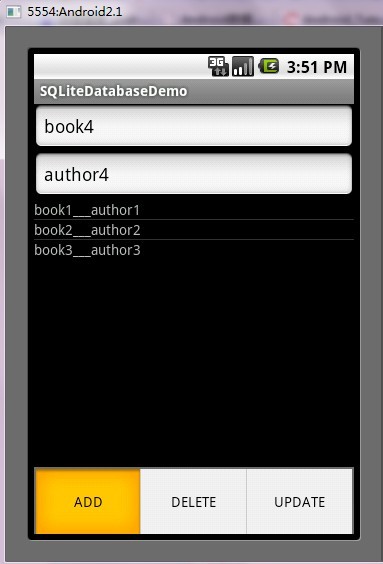
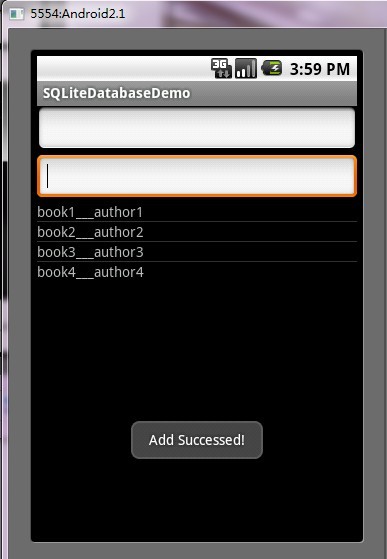
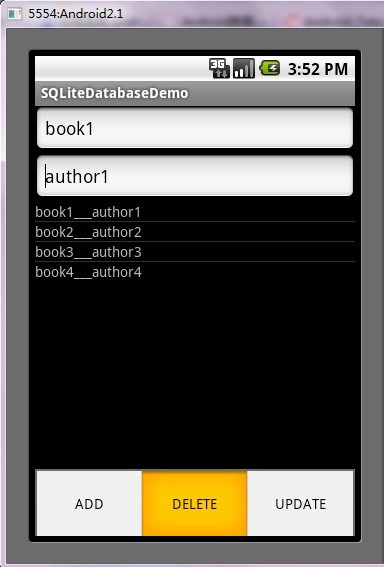
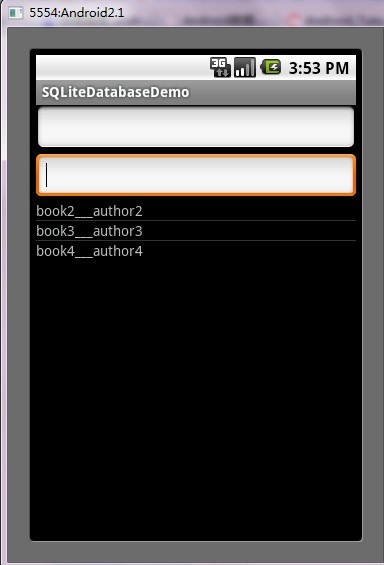
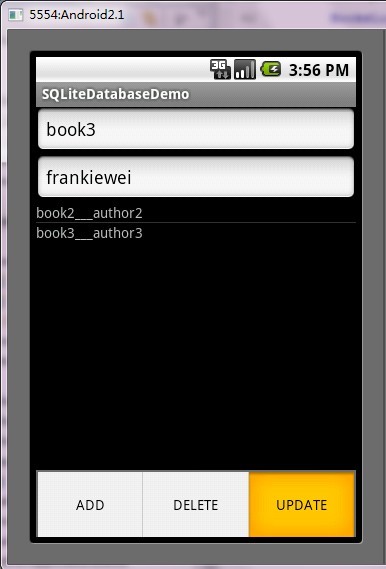
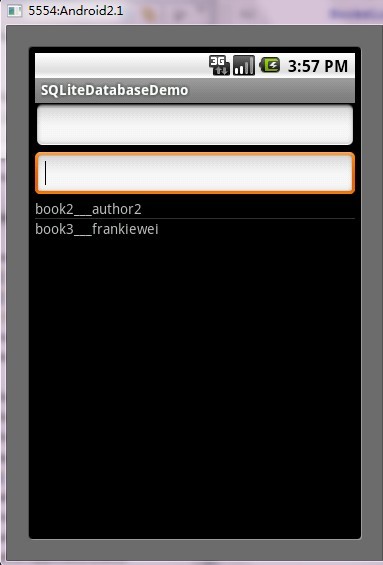
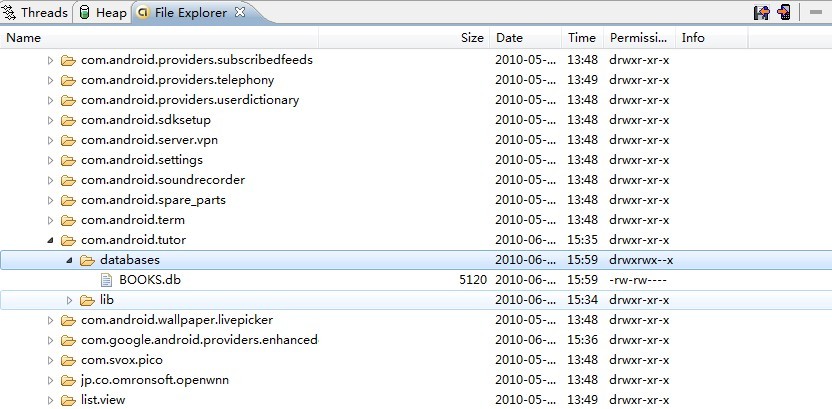
ANDROID开发之SQLite详解
发布于:2014-7-22 9:47 作者:admin 浏览:2145 分类:AndroidSQLite简介
Google为Andriod的较大的数据处理提供了SQLite,他在数据存储、管理、维护等各方面都相当出色,功能也非常的强大。SQLite具备下列特点:
1.轻量级
使用 SQLite 只需要带一个动态库,就可以享受它的全部功能,而且那个动态库的尺寸想当小。
2.独立性
SQLite 数据库的核心引擎不需要依赖第三方软件,也不需要所谓的“安装”。
3.隔离性
SQLite 数据库中所有的信息(比如表、视图、触发器等)都包含在一个文件夹内,方便管理和维护。
4.跨平台
SQLite 目前支持大部分操作系统,不至电脑操作系统更在众多的手机系统也是能够运行,比如:Android。
5.多语言接口
SQLite 数据库支持多语言编程接口。
6.安全性
SQLite 数据库通过数据库级上的独占性和共享锁来实现独立事务处理。这意味着多个进程可以在同一时间从同一数据库读取数据,但只能有一个可以写入数据。
Android中的SQLite使用
首先创建数据库类
|
public class DatabaseHelperextends SQLiteOpenHelper {
private static final String DB_NAME ="mydata.db";//数据库名称
private static final int version =1;//数据库版本
public DatabaseHelper(Context context) {
super(context, DB_NAME,null, version);
// TODO Auto-generated constructor stub
}
@Override
public void onCreate(SQLiteDatabase db) {
String sql ="create table user(username varchar(20) not null , password varchar(60) not null );";
db.execSQL(sql);
}
@Override
public void onUpgrade(SQLiteDatabase db,int oldVersion,int newVersion) {
// TODO Auto-generated method stub
}
}
|
SQLiteOpenHelper类介绍
SQLiteOpenHelper是SQLiteDatabase的一个帮助类,用来管理数据库的创建和版本的更新。一般是建立一个类继承它,并实现它的onCreate和onUpgrade方法。
| 方法名 | 方法描述 |
|---|---|
| SQLiteOpenHelper(Context context,String name,SQLiteDatabase.CursorFactory factory,int version) | 构造方法,一般是传递一个要创建的数据库名称那么参数 |
| onCreate(SQLiteDatabase db) | 创建数据库时调用 |
| onUpgrade(SQLiteDatabase db,int oldVersion , int newVersion) | 版本更新时调用 |
| getReadableDatabase() | 创建或打开一个只读数据库 |
| getWritableDatabase() | 创建或打开一个读写数据库 |
下面来介绍调用的方法
创建数据库
这里特别的地方是通过调用了SQLiteOpenHelper类的getReadableDatabase()方法来实现创建一个数据库的
|
1
2
3
|
DatabaseHelper database =new DatabaseHelper(this);//这段代码放到Activity类中才用this
SQLiteDatabase db =null;
db = database.getReadalbeDatabase();
|
SQLiteDatabase类为我们提供了很多种方法,而较常用的方法如下
| (返回值)方法名 | 方法描述 |
|---|---|
| (int) delete(String table,String whereClause,String[] whereArgs) | 删除数据行的便捷方法 |
| (long) insert(String table,String nullColumnHack,ContentValues values) | 添加数据行的便捷方法 |
| (int) update(String table, ContentValues values, String whereClause, String[] whereArgs) | 更新数据行的便捷方法 |
| (void) execSQL(String sql) | 执行一个SQL语句,可以是一个select或其他的sql语句 |
| (void) close() | 关闭数据库 |
| (Cursor) query(String table, String[] columns, String selection, String[] selectionArgs, String groupBy, String having, String orderBy, String limit) | 查询指定的数据表返回一个带游标的数据集 |
| (Cursor) rawQuery(String sql, String[] selectionArgs) | 运行一个预置的SQL语句,返回带游标的数据集(与上面的语句最大的区别就是防止SQL注入) |
数据的添删改查分别可以通过2种途径来实现
数据的添加
1.使用insert方法
|
1
2
3
|
ContentValues cv =new ContentValues();//实例化一个ContentValues用来装载待插入的数据cv.put("username","Jack Johnson");//添加用户名
cv.put("password","iLovePopMusic");//添加密码
db.insert("user",null,cv);//执行插入操作
|
2.使用execSQL方式来实现
|
1
2
|
String sql = "insert into user(username,password) values ('Jack Johnson','iLovePopMuisc');//插入操作的SQL语句
db.execSQL(sql);//执行SQL语句
|
数据的删除
同样有2种方式可以实现
|
1
2
3
|
String whereClause ="username=?";//删除的条件
String[] whereArgs = {"Jack Johnson"};//删除的条件参数
db.delete("user",whereClause,whereArgs);//执行删除
|
使用execSQL方式的实现
|
1
2
|
String sql ="delete from user where username='Jack Johnson'";//删除操作的SQL语句
db.execSQL(sql);//执行删除操作
|
数据修改
同上,仍是2种方式
|
1
2
3
4
5
|
ContentValues cv =new ContentValues();//实例化ContentValues
cv.put("password","iHatePopMusic");//添加要更改的字段及内容
String whereClause ="username=?";//修改条件
String[] whereArgs = {"Jack Johnson"};//修改条件的参数
db.update("user",cv,whereClause,whereArgs);//执行修改
|
使用execSQL方式的实现
|
1
2
|
String sql ="update [user] set password = 'iHatePopMusic' where username='Jack Johnson'";//修改的SQL语句
db.execSQL(sql);//执行修改
|
数据查询
数据查询相对前面几种方法就复杂一些了,因为查询会带有很多条件
通过query实现查询的
public Cursor query(String table, String[] columns, String selection, String[] selectionArgs, String groupBy, String having, String orderBy, String limit)
各参数说明:
- table:表名称
- colums:列名称数组
- selection:条件子句,相当于where
- selectionArgs:条件语句的参数数组
- groupBy:分组
- having:分组条件
- orderBy:排序类
- limit:分页查询的限制
- Cursor:返回值,相当于结果集ResultSet
针对游标(Cursor)也提供了不少方法
| 方法名称 | 方法描述 |
|---|---|
| getCount() | 总记录条数 |
| isFirst() | 判断是否第一条记录 |
| isLast() | 判断是否最后一条记录 |
| moveToFirst() | 移动到第一条记录 |
| moveToLast() | 移动到最后一条记录 |
| move(int offset) | 移动到指定的记录 |
| moveToNext() | 移动到吓一条记录 |
| moveToPrevious() | 移动到上一条记录 |
| getColumnIndex(String columnName) | 获得指定列索引的int类型值 |
实现代码
|
1
2
3
4
5
6
7
8
|
Cursor c = db.query("user",null,null,null,null,null,null);//查询并获得游标
if(c.moveToFirst()){//判断游标是否为空
for(int i=0;i<c.getCount();i++){
c.move(i);//移动到指定记录
String username = c.getString(c.getColumnIndex("username");
String password = c.getString(c.getColumnIndex("password"));
}
}
|
通过rawQuery实现的带参数查询
|
1
2
3
4
|
Cursor c = db.rawQuery("select * from user where username=?",new Stirng[]{"Jack Johnson"});
if(cursor.moveToFirst()) {
String password = c.getString(c.getColumnIndex("password"));
}
|
Android中SQLite应用详解
发布于:2014-7-22 9:35 作者:admin 浏览:2210 分类:Android现在的主流移动设备像Android、iPhone等都使用SQLite作为复杂数据的存储引擎,在我们为移动设备开发应用程序时,也许就要使用到SQLite来存储我们大量的数据,所以我们就需要掌握移动设备上的SQLite开发技巧。对于Android平台来说,系统内置了丰富的API来供开发人员操作SQLite,我们可以轻松的完成对数据的存取。
下面就向大家介绍一下SQLite常用的操作方法,为了方便,我将代码写在了Activity的onCreate中:
@Override
protected void onCreate(Bundle savedInstanceState) {
super.onCreate(savedInstanceState);
//打开或创建test.db数据库
SQLiteDatabase db = openOrCreateDatabase("test.db", Context.MODE_PRIVATE, null);
db.execSQL("DROP TABLE IF EXISTS person");
//创建person表
db.execSQL("CREATE TABLE person (_id INTEGER PRIMARY KEY AUTOINCREMENT, name VARCHAR, age SMALLINT)");
Person person = new Person();
person.name = "john";
person.age = 30;
//插入数据
db.execSQL("INSERT INTO person VALUES (NULL, ?, ?)", new Object[]{person.name, person.age});
person.name = "david";
person.age = 33;
//ContentValues以键值对的形式存放数据
ContentValues cv = new ContentValues();
cv.put("name", person.name);
cv.put("age", person.age);
//插入ContentValues中的数据
db.insert("person", null, cv);
cv = new ContentValues();
cv.put("age", 35);
//更新数据
db.update("person", cv, "name = ?", new String[]{"john"});
Cursor c = db.rawQuery("SELECT * FROM person WHERE age >= ?", new String[]{"33"});
while (c.moveToNext()) {
int _id = c.getInt(c.getColumnIndex("_id"));
String name = c.getString(c.getColumnIndex("name"));
int age = c.getInt(c.getColumnIndex("age"));
Log.i("db", "_id=>" + _id + ", name=>" + name + ", age=>" + age);
}
c.close();
//删除数据
db.delete("person", "age < ?", new String[]{"35"});
//关闭当前数据库
db.close();
//删除test.db数据库
// deleteDatabase("test.db");
}
在执行完上面的代码后,系统就会在/data/data/[PACKAGE_NAME]/databases目录下生成一个“test.db”的数据库文件,如图:
上面的代码中基本上囊括了大部分的数据库操作;对于添加、更新和删除来说,我们都可以使用
- db.executeSQL(String sql);
- db.executeSQL(String sql, Object[] bindArgs);//sql语句中使用占位符,然后第二个参数是实际的参数集
- db.insert(String table, String nullColumnHack, ContentValues values);
- db.update(String table, Contentvalues values, String whereClause, String whereArgs);
- db.delete(String table, String whereClause, String whereArgs);
下面来说说查询操作。查询操作相对于上面的几种操作要复杂些,因为我们经常要面对着各种各样的查询条件,所以系统也考虑到这种复杂性,为我们提供了较为丰富的查询形式:
- db.rawQuery(String sql, String[] selectionArgs);
- db.query(String table, String[] columns, String selection, String[] selectionArgs, String groupBy, String having, String orderBy);
- db.query(String table, String[] columns, String selection, String[] selectionArgs, String groupBy, String having, String orderBy, String limit);
- db.query(String distinct, String table, String[] columns, String selection, String[] selectionArgs, String groupBy, String having, String orderBy, String limit);
最后,他们同时返回一个Cursor对象,代表数据集的游标,有点类似于JavaSE中的ResultSet。
下面是Cursor对象的常用方法
- c.move(int offset); //以当前位置为参考,移动到指定行
- c.moveToFirst(); //移动到第一行
- c.moveToLast(); //移动到最后一行
- c.moveToPosition(int position); //移动到指定行
- c.moveToPrevious(); //移动到前一行
- c.moveToNext(); //移动到下一行
- c.isFirst(); //是否指向第一条
- c.isLast(); //是否指向最后一条
- c.isBeforeFirst(); //是否指向第一条之前
- c.isAfterLast(); //是否指向最后一条之后
- c.isNull(int columnIndex); //指定列是否为空(列基数为0)
- c.isClosed(); //游标是否已关闭
- c.getCount(); //总数据项数
- c.getPosition(); //返回当前游标所指向的行数
- c.getColumnIndex(String columnName);//返回某列名对应的列索引值
- c.getString(int columnIndex); //返回当前行指定列的值
在上面的代码示例中,已经用到了这几个常用方法中的一些,关于更多的信息,大家可以参考官方文档中的说明。
最后当我们完成了对数据库的操作后,记得调用SQLiteDatabase的close()方法释放数据库连接,否则容易出现SQLiteException。
上面就是SQLite的基本应用,但在实际开发中,为了能够更好的管理和维护数据库,我们会封装一个继承自SQLiteOpenHelper类的数据库操作类,然后以这个类为基础,再封装我们的业务逻辑方法。
下面,我们就以一个实例来讲解具体的用法,我们新建一个名为db的项目,结构如下:

其中DBHelper继承了SQLiteOpenHelper,作为维护和管理数据库的基类,DBManager是建立在DBHelper之上,封装了常用的业务方法,Person是我们的person表对应的JavaBean,MainActivity就是我们显示的界面。
下面我们先来看一下DBHelper:
- package com.scott.db;
- import android.content.Context;
- import android.database.sqlite.SQLiteDatabase;
- import android.database.sqlite.SQLiteOpenHelper;
- public class DBHelper extends SQLiteOpenHelper {
- private static final String DATABASE_NAME = "test.db";
- private static final int DATABASE_VERSION = 1;
- public DBHelper(Context context) {
- //CursorFactory设置为null,使用默认值
- super(context, DATABASE_NAME, null, DATABASE_VERSION);
- }
- //数据库第一次被创建时onCreate会被调用
- @Override
- public void onCreate(SQLiteDatabase db) {
- db.execSQL("CREATE TABLE IF NOT EXISTS person" +
- "(_id INTEGER PRIMARY KEY AUTOINCREMENT, name VARCHAR, age INTEGER, info TEXT)");
- }
- //如果DATABASE_VERSION值被改为2,系统发现现有数据库版本不同,即会调用onUpgrade
- @Override
- public void onUpgrade(SQLiteDatabase db, int oldVersion, int newVersion) {
- db.execSQL("ALTER TABLE person ADD COLUMN other STRING");
- }
- }
为了方便我们面向对象的使用数据,我们建一个Person类,对应person表中的字段,如下:
- package com.scott.db;
- public class Person {
- public int _id;
- public String name;
- public int age;
- public String info;
- public Person() {
- }
- public Person(String name, int age, String info) {
- this.name = name;
- this.age = age;
- this.info = info;
- }
- }
- package com.scott.db;
- import java.util.ArrayList;
- import java.util.List;
- import android.content.ContentValues;
- import android.content.Context;
- import android.database.Cursor;
- import android.database.sqlite.SQLiteDatabase;
- public class DBManager {
- private DBHelper helper;
- private SQLiteDatabase db;
- public DBManager(Context context) {
- helper = new DBHelper(context);
- //因为getWritableDatabase内部调用了mContext.openOrCreateDatabase(mName, 0, mFactory);
- //所以要确保context已初始化,我们可以把实例化DBManager的步骤放在Activity的onCreate里
- db = helper.getWritableDatabase();
- }
- /**
- * add persons
- * @param persons
- */
- public void add(List<Person> persons) {
- db.beginTransaction(); //开始事务
- try {
- for (Person person : persons) {
- db.execSQL("INSERT INTO person VALUES(null, ?, ?, ?)", new Object[]{person.name, person.age, person.info});
- }
- db.setTransactionSuccessful(); //设置事务成功完成
- } finally {
- db.endTransaction(); //结束事务
- }
- }
- /**
- * update person's age
- * @param person
- */
- public void updateAge(Person person) {
- ContentValues cv = new ContentValues();
- cv.put("age", person.age);
- db.update("person", cv, "name = ?", new String[]{person.name});
- }
- /**
- * delete old person
- * @param person
- */
- public void deleteOldPerson(Person person) {
- db.delete("person", "age >= ?", new String[]{String.valueOf(person.age)});
- }
- /**
- * query all persons, return list
- * @return List<Person>
- */
- public List<Person> query() {
- ArrayList<Person> persons = new ArrayList<Person>();
- Cursor c = queryTheCursor();
- while (c.moveToNext()) {
- Person person = new Person();
- person._id = c.getInt(c.getColumnIndex("_id"));
- person.name = c.getString(c.getColumnIndex("name"));
- person.age = c.getInt(c.getColumnIndex("age"));
- person.info = c.getString(c.getColumnIndex("info"));
- persons.add(person);
- }
- c.close();
- return persons;
- }
- /**
- * query all persons, return cursor
- * @return Cursor
- */
- public Cursor queryTheCursor() {
- Cursor c = db.rawQuery("SELECT * FROM person", null);
- return c;
- }
- /**
- * close database
- */
- public void closeDB() {
- db.close();
- }
- }
我们获取数据库实例时使用了getWritableDatabase()方法,也许朋友们会有疑问,在getWritableDatabase()和getReadableDatabase()中,你为什么选择前者作为整个应用的数据库实例呢?在这里我想和大家着重分析一下这一点。
我们来看一下SQLiteOpenHelper中的getReadableDatabase()方法:
- public synchronized SQLiteDatabase getReadableDatabase() {
- if (mDatabase != null && mDatabase.isOpen()) {
- // 如果发现mDatabase不为空并且已经打开则直接返回
- return mDatabase;
- }
- if (mIsInitializing) {
- // 如果正在初始化则抛出异常
- throw new IllegalStateException("getReadableDatabase called recursively");
- }
- // 开始实例化数据库mDatabase
- try {
- // 注意这里是调用了getWritableDatabase()方法
- return getWritableDatabase();
- } catch (SQLiteException e) {
- if (mName == null)
- throw e; // Can't open a temp database read-only!
- Log.e(TAG, "Couldn't open " + mName + " for writing (will try read-only):", e);
- }
- // 如果无法以可读写模式打开数据库 则以只读方式打开
- SQLiteDatabase db = null;
- try {
- mIsInitializing = true;
- String path = mContext.getDatabasePath(mName).getPath();// 获取数据库路径
- // 以只读方式打开数据库
- db = SQLiteDatabase.openDatabase(path, mFactory, SQLiteDatabase.OPEN_READONLY);
- if (db.getVersion() != mNewVersion) {
- throw new SQLiteException("Can't upgrade read-only database from version " + db.getVersion() + " to "
- + mNewVersion + ": " + path);
- }
- onOpen(db);
- Log.w(TAG, "Opened " + mName + " in read-only mode");
- mDatabase = db;// 为mDatabase指定新打开的数据库
- return mDatabase;// 返回打开的数据库
- } finally {
- mIsInitializing = false;
- if (db != null && db != mDatabase)
- db.close();
- }
- }
- public synchronized SQLiteDatabase getWritableDatabase() {
- if (mDatabase != null && mDatabase.isOpen() && !mDatabase.isReadOnly()) {
- // 如果mDatabase不为空已打开并且不是只读模式 则返回该实例
- return mDatabase;
- }
- if (mIsInitializing) {
- throw new IllegalStateException("getWritableDatabase called recursively");
- }
- // If we have a read-only database open, someone could be using it
- // (though they shouldn't), which would cause a lock to be held on
- // the file, and our attempts to open the database read-write would
- // fail waiting for the file lock. To prevent that, we acquire the
- // lock on the read-only database, which shuts out other users.
- boolean success = false;
- SQLiteDatabase db = null;
- // 如果mDatabase不为空则加锁 阻止其他的操作
- if (mDatabase != null)
- mDatabase.lock();
- try {
- mIsInitializing = true;
- if (mName == null) {
- db = SQLiteDatabase.create(null);
- } else {
- // 打开或创建数据库
- db = mContext.openOrCreateDatabase(mName, 0, mFactory);
- }
- // 获取数据库版本(如果刚创建的数据库,版本为0)
- int version = db.getVersion();
- // 比较版本(我们代码中的版本mNewVersion为1)
- if (version != mNewVersion) {
- db.beginTransaction();// 开始事务
- try {
- if (version == 0) {
- // 执行我们的onCreate方法
- onCreate(db);
- } else {
- // 如果我们应用升级了mNewVersion为2,而原版本为1则执行onUpgrade方法
- onUpgrade(db, version, mNewVersion);
- }
- db.setVersion(mNewVersion);// 设置最新版本
- db.setTransactionSuccessful();// 设置事务成功
- } finally {
- db.endTransaction();// 结束事务
- }
- }
- onOpen(db);
- success = true;
- return db;// 返回可读写模式的数据库实例
- } finally {
- mIsInitializing = false;
- if (success) {
- // 打开成功
- if (mDatabase != null) {
- // 如果mDatabase有值则先关闭
- try {
- mDatabase.close();
- } catch (Exception e) {
- }
- mDatabase.unlock();// 解锁
- }
- mDatabase = db;// 赋值给mDatabase
- } else {
- // 打开失败的情况:解锁、关闭
- if (mDatabase != null)
- mDatabase.unlock();
- if (db != null)
- db.close();
- }
- }
- }
看完上面的过程之后,大家或许就清楚了许多,如果不是在遇到磁盘空间已满等情况,getReadableDatabase()一般都会返回和getWritableDatabase()一样的数据库实例,所以我们在DBManager构造方法中使用getWritableDatabase()获取整个应用所使用的数据库实例是可行的。当然如果你真的担心这种情况会发生,那么你可以先用getWritableDatabase()获取数据实例,如果遇到异常,再试图用getReadableDatabase()获取实例,当然这个时候你获取的实例只能读不能写了。
最后,让我们看一下如何使用这些数据操作方法来显示数据,下面是MainActivity.java的布局文件和代码:
- <?xml version="1.0" encoding="utf-8"?>
- <LinearLayout xmlns:android="http://schemas.android.com/apk/res/android"
- android:orientation="vertical"
- android:layout_width="fill_parent"
- android:layout_height="fill_parent">
- <Button
- android:layout_width="fill_parent"
- android:layout_height="wrap_content"
- android:text="add"
- android:onClick="add"/>
- <Button
- android:layout_width="fill_parent"
- android:layout_height="wrap_content"
- android:text="update"
- android:onClick="update"/>
- <Button
- android:layout_width="fill_parent"
- android:layout_height="wrap_content"
- android:text="delete"
- android:onClick="delete"/>
- <Button
- android:layout_width="fill_parent"
- android:layout_height="wrap_content"
- android:text="query"
- android:onClick="query"/>
- <Button
- android:layout_width="fill_parent"
- android:layout_height="wrap_content"
- android:text="queryTheCursor"
- android:onClick="queryTheCursor"/>
- <ListView
- android:id="@+id/listView"
- android:layout_width="fill_parent"
- android:layout_height="wrap_content"/>
- </LinearLayout>
- package com.scott.db;
- import java.util.ArrayList;
- import java.util.HashMap;
- import java.util.List;
- import java.util.Map;
- import android.app.Activity;
- import android.database.Cursor;
- import android.database.CursorWrapper;
- import android.os.Bundle;
- import android.view.View;
- import android.widget.ListView;
- import android.widget.SimpleAdapter;
- import android.widget.SimpleCursorAdapter;
- public class MainActivity extends Activity {
- private DBManager mgr;
- private ListView listView;
- @Override
- public void onCreate(Bundle savedInstanceState) {
- super.onCreate(savedInstanceState);
- setContentView(R.layout.main);
- listView = (ListView) findViewById(R.id.listView);
- //初始化DBManager
- mgr = new DBManager(this);
- }
- @Override
- protected void onDestroy() {
- super.onDestroy();
- //应用的最后一个Activity关闭时应释放DB
- mgr.closeDB();
- }
- public void add(View view) {
- ArrayList<Person> persons = new ArrayList<Person>();
- Person person1 = new Person("Ella", 22, "lively girl");
- Person person2 = new Person("Jenny", 22, "beautiful girl");
- Person person3 = new Person("Jessica", 23, "sexy girl");
- Person person4 = new Person("Kelly", 23, "hot baby");
- Person person5 = new Person("Jane", 25, "a pretty woman");
- persons.add(person1);
- persons.add(person2);
- persons.add(person3);
- persons.add(person4);
- persons.add(person5);
- mgr.add(persons);
- }
- public void update(View view) {
- Person person = new Person();
- person.name = "Jane";
- person.age = 30;
- mgr.updateAge(person);
- }
- public void delete(View view) {
- Person person = new Person();
- person.age = 30;
- mgr.deleteOldPerson(person);
- }
- public void query(View view) {
- List<Person> persons = mgr.query();
- ArrayList<Map<String, String>> list = new ArrayList<Map<String, String>>();
- for (Person person : persons) {
- HashMap<String, String> map = new HashMap<String, String>();
- map.put("name", person.name);
- map.put("info", person.age + " years old, " + person.info);
- list.add(map);
- }
- SimpleAdapter adapter = new SimpleAdapter(this, list, android.R.layout.simple_list_item_2,
- new String[]{"name", "info"}, new int[]{android.R.id.text1, android.R.id.text2});
- listView.setAdapter(adapter);
- }
- public void queryTheCursor(View view) {
- Cursor c = mgr.queryTheCursor();
- startManagingCursor(c); //托付给activity根据自己的生命周期去管理Cursor的生命周期
- CursorWrapper cursorWrapper = new CursorWrapper(c) {
- @Override
- public String getString(int columnIndex) {
- //将简介前加上年龄
- if (getColumnName(columnIndex).equals("info")) {
- int age = getInt(getColumnIndex("age"));
- return age + " years old, " + super.getString(columnIndex);
- }
- return super.getString(columnIndex);
- }
- };
- //确保查询结果中有"_id"列
- SimpleCursorAdapter adapter = new SimpleCursorAdapter(this, android.R.layout.simple_list_item_2,
- cursorWrapper, new String[]{"name", "info"}, new int[]{android.R.id.text1, android.R.id.text2});
- ListView listView = (ListView) findViewById(R.id.listView);
- listView.setAdapter(adapter);
- }
- }
如果手动去管理Cursor的话会非常的麻烦,还有一定的风险,处理不当的话运行期间就会出现异常,幸好Activity为我们提供了startManagingCursor(Cursor cursor)方法,它会根据Activity的生命周期去管理当前的Cursor对象,下面是该方法的说明:
- /**
- * This method allows the activity to take care of managing the given
- * {@link Cursor}'s lifecycle for you based on the activity's lifecycle.
- * That is, when the activity is stopped it will automatically call
- * {@link Cursor#deactivate} on the given Cursor, and when it is later restarted
- * it will call {@link Cursor#requery} for you. When the activity is
- * destroyed, all managed Cursors will be closed automatically.
- *
- * @param c The Cursor to be managed.
- *
- * @see #managedQuery(android.net.Uri , String[], String, String[], String)
- * @see #stopManagingCursor
- */
如何包装Cursor:我们会使用到CursorWrapper对象去包装我们的Cursor对象,实现我们需要的数据转换工作,这个CursorWrapper实际上是实现了Cursor接口。我们查询获取到的Cursor其实是Cursor的引用,而系统实际返回给我们的必然是Cursor接口的一个实现类的对象实例,我们用CursorWrapper包装这个实例,然后再使用SimpleCursorAdapter将结果显示到列表上。
Cursor结果集需要注意些什么:一个最需要注意的是,在我们的结果集中必须要包含一个“_id”的列,否则SimpleCursorAdapter就会翻脸不认人,为什么一定要这样呢?因为这源于SQLite的规范,主键以“_id”为标准。解决办法有三:第一,建表时根据规范去做;第二,查询时用别名,例如:SELECT id AS _id FROM person;第三,在CursorWrapper里做文章:
- CursorWrapper cursorWrapper = new CursorWrapper(c) {
- @Override
- public int getColumnIndexOrThrow(String columnName) throws IllegalArgumentException {
- if (columnName.equals("_id")) {
- return super.getColumnIndex("id");
- }
- return super.getColumnIndexOrThrow(columnName);
- }
- };

